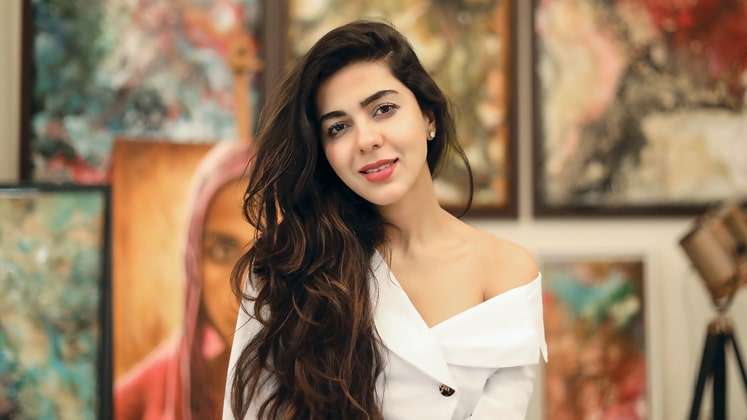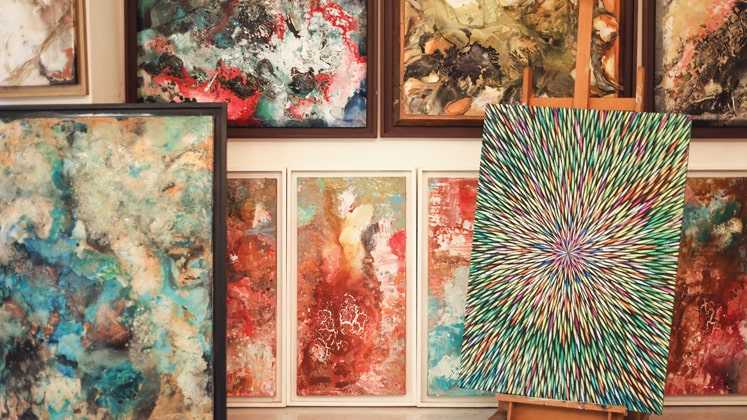
A scholar and an artist – Bahaar Dhawan Rohatgi has a life story that many would find inspiring. Having already sold over 250 works from when she started getting noticed during her office days 7 years ago, Bahaar has come a long way while creating a niche for herself in an often overlooked industry in our country – the art world.
Awarded by ASSOCHAM at the SAARC Women Economic Forum 2017 as the best emerging artist, Bahaar has exhibited her artworks in more than 30 shows in India and abroad, including the prestigious Arte Laguna in Venice last year and in Dubai earlier this year. Today, her art can be spotted at numerous private and corporate collections in India and abroad, including with the Hon’ble President of India, the royal family of Abu Dhabi, DLF, Park Hotels, Hindustan Times, leading law and corporate offices of the country, apart from many prominent collectors.
Growing up, the lawyer-turned-artist always had the germ of creativity within her, even while donning many hats of being a bulletin board head, sports captain and also the school prefect.
After finishing school, Bahaar appeared for multiple and varied university entrances only to emerge as a topper in each and every one of them be it the NIFT exam or the Amity Law entrance. Owing to her strong streak in academics, her family urged her to undertake a more ‘stable’ career choice which led her to the world of Law. In a candid conversation with Apparel Resources India, Bahaar narrates her bent for creativity as a passionate artist since childhood and her gradual journey to success.
AR: How and why did you switch gears from being a lawyer to an artist?
BDR : Moving to Pune to pursue Law was a great decision for me in terms of exposure. Being good at academics made me one of the first few students to get a job with the top law firm of the country – Shardul Amarchand Mangaldas – after which there was no looking back for me.
Law interests me immensely and the idea was never to leave law, but I always had this urge in me to create. So even while working, I would occasionally paint and while doing that, people started noticing and buying my work which was a huge motivating factor for me. This led me to reassess my situation and think that maybe I should do more of this. I devoted 5 years to the law firm but I always had the fire within me which kept simmering but it never went out.
Then marriage happened which was the actual tipping point because I knew I couldn’t any more put in the crazy hours demanded by a career in Law.
AR: How did you put your work out there?
BDR : One thing led to the other and social media is just a consequence of it all. Because of my work at large and because it requires communicating with so many people, I knew that I cannot keep waiting for the next show to happen to get noticed. I decided that I am the creator and that there is nothing that can stop me from reaching out and telling people what I am doing; it’s up to them whether they want to take it or not.
This is something I also talk about a lot when we are conditioning young minds about how art is or how art should be – I want aspiring artists to know that you don’t need any validation because this is your own individualistic experience and not everyone has to agree with that.
I have never contacted any buyer – I was just using one free platform that I had at my disposal, that is Facebook – and now Instagram and word of mouth. Gradually people started hearing about my work and I started participating in shows one after the other.
AR : How would you define your style of work?
What inspires you as an artist? BDR: I am a multi-disciplinary artist – I don’t just paint, I also sculpt. My style is abstract, but I like to experiment with various mediums such as paint, paper, rubber, resin, cement, sand, etc. I am also a huge supporter of sustainable materials and work a lot with used objects such as fallen trees, scrap metal, broken doors. I like to incorporate the Japanese concept of wabi-sabi, which calls for seeing beauty in the flawed or imperfect. I take broken things and try to create beauty out of them. Sometimes I create a lot of natural pigments from my travels, and I like adding layers over layers of art.
I am also known for my sculptural relief work. This is something which no one else in the country practises – the characteristic layering technique which is what makes my work a little different. I have devised a unique way of burning resin and reducing rubber together to give a structural effect on the base.
As a self-taught artist, I never stop seeking. I really believe in energies so I also like creating work in accordance with the energy I’m trying to evoke. I am constantly inspired by the cosmos and galaxies, landscapes and the experiences/ conversations I carry from my travels. Owls are cosmic creatures – they appear a lot in my work, and so do the feminine forms.
I have also created artworks in Virtual Reality, sensorial kinetic sculptures and a sculptural walk in tour through a new civilisation.
AR : Has your experience in Law impacted your career in art anyway?
BDR: I often work on themes that depict social messages or address social concerns. Social causes come very naturally to me and because of my past experience in Law, I have always had a zest in me for justice. I feel that if we are in a privileged position where we have got the education and the resources, it’s very important to give back to the society in some way because not everyone is that fortunate.
I have addressed issues regarding terrorism, women’s rights and questioned social evils and superstitions in relation to owls in the country during the time when demonetisation had just kicked in.
As I got into art, I realised how artists are at the bottom of the so-called food chain – things were really operating in a vacuum. For one to take to the arts domain is in itself a courageous step, especially without a father figure in the industry, as there is a lot of struggle associated with this field. It’s a market which is not too stable because I think somewhere even artists have not taken too much charge on their own.
AR: How are you trying to further Art Law in the country?
BDR : I advise people on how to enter contracts so that there are no hidden surprises tomorrow. This is one way I am trying to give back to the artists by spreading awareness about how they can operate in an environment where there are no solid laws backing one up.
We lobbied for ensuring that taxes are kept low and aren’t put into the luxury bracket which was 18 per cent earlier; we have now got it down to 12 per cent now. I also met our Prime Minister for raising concerns regarding the future of Art Law in India. I wanted to make them realise that art is not a luxury product – there are a lot of artisans and creative people belonging to the lower strata of society who have been creating art, have been kalakaars for numbers of years – who will get wiped out if the taxes are high making our country lose out on a huge pool of indigenous talent.
Another thing I really try to promote is price uniformity. Works of artists need to be uniformly priced no matter where one buys them. You can’t have different prices at stores and different prices at galleries because then no one would buy that art from the galleries. You have to be very ethical and these are the things artists should keep in mind.

AR: What would your advice be to entrepreneurs looking to venture into an uncharted territory which they have not been formally educated in?
BDR : It does not matter who decides you’re creative – someone who does not understand your journey cannot decide what’s right or wrong. In fact creativity is such a nebulous concept that you cannot ascribe parameters which you can test and assess. It’s not about your knowledge on art history or your foundation skills or any other basics which are taught in an art school – it is about being creative and being a bit fearless.
There is no dearth of talent in this country but not many hone it. It’s all about being prepared when the opportunity comes at the door and even if it doesn’t, you can create it.
There are predominantly 4 elements we look at:
You should be willing to take the bull by its horns – basically not get too challenged by the unfamiliar that you hold back from taking the next step.
Being comfortable with not knowing what should be done, you should be able to ideate; that is, let your ideas lead the learning. If you have ideas, don’t let them stop because those are emanating from your original experiences.
You should be able to visualise and execute – once you visualise how you’re going to communicate the ideas, get down to make them happen. In Law, there is this concept that idea has no protection – but what you create out of it, that gets protection.
It is very important to be a researcher. So being comfortable with not knowing to then visualising and then enforcing – these are the steps one can take to explore creativity at its best.
AR: How do you think art is perceived in the fast-paced digital world of today?
BDR : At a time, where people have no patience to read, Instagram is doing way better than other social media platforms such as Twitter and Facebook, because people don’t want to read – you just have 3 seconds to capture the interest of your audience.
What you can communicate through visuals can have a lasting impact on you. It doesn’t always have to sell – it also has to sometimes just be a medium of communicating with art and a picture can speak a thousand words.
The one time I feel free is when I’m creating because I can do anything and everything and it is therapeutic. And I strongly feel that in the future, art will become one of the greatest sources of therapy and creating something with your own hands which is not related to digital media will be regarded as therapy.
AR: Who are the artists that inspire you?
BDR : I am constantly inspired by artists such as Sabavala and GR Santosh because I have always loved abstraction. I also really like the palette Shakti Burman uses and I enjoy the design sense of Scandinavian artists.

Post a Comment